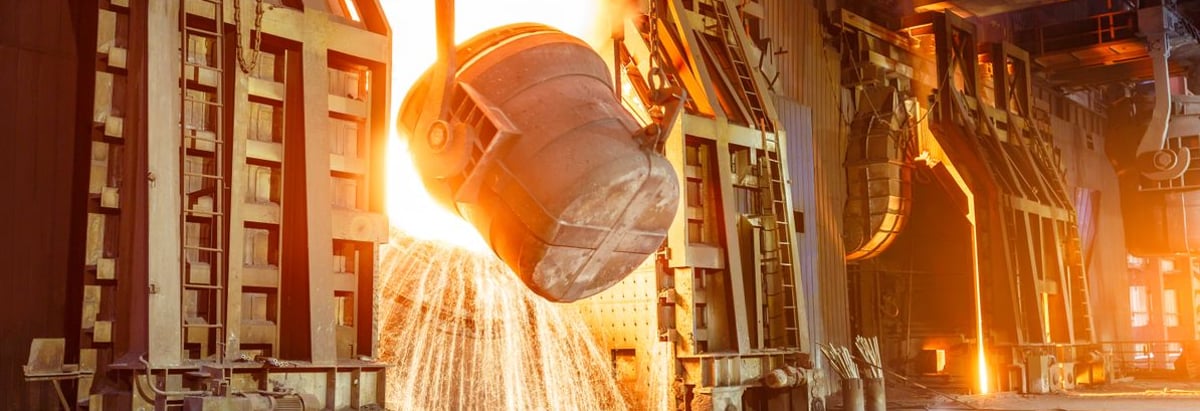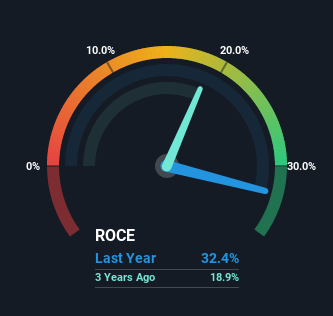- India
- /
- Metals and Mining
- /
- NSEI:JSLHISAR
Jindal Stainless (Hisar) (NSE:JSLHISAR) Is Achieving High Returns On Its Capital

To find a multi-bagger stock, what are the underlying trends we should look for in a business? One common approach is to try and find a company with returns on capital employed (ROCE) that are increasing, in conjunction with a growing amount of capital employed. Put simply, these types of businesses are compounding machines, meaning they are continually reinvesting their earnings at ever-higher rates of return. So when we looked at the ROCE trend of Jindal Stainless (Hisar) (NSE:JSLHISAR) we really liked what we saw.
Return On Capital Employed (ROCE): What is it?
Just to clarify if you're unsure, ROCE is a metric for evaluating how much pre-tax income (in percentage terms) a company earns on the capital invested in its business. Analysts use this formula to calculate it for Jindal Stainless (Hisar):
Return on Capital Employed = Earnings Before Interest and Tax (EBIT) ÷ (Total Assets - Current Liabilities)
0.32 = ₹20b ÷ (₹99b - ₹37b) (Based on the trailing twelve months to March 2022).
So, Jindal Stainless (Hisar) has an ROCE of 32%. In absolute terms that's a great return and it's even better than the Metals and Mining industry average of 17%.
Check out our latest analysis for Jindal Stainless (Hisar)

Above you can see how the current ROCE for Jindal Stainless (Hisar) compares to its prior returns on capital, but there's only so much you can tell from the past. If you're interested, you can view the analysts predictions in our free report on analyst forecasts for the company.
The Trend Of ROCE
Investors would be pleased with what's happening at Jindal Stainless (Hisar). Over the last five years, returns on capital employed have risen substantially to 32%. Basically the business is earning more per dollar of capital invested and in addition to that, 82% more capital is being employed now too. The increasing returns on a growing amount of capital is common amongst multi-baggers and that's why we're impressed.
In another part of our analysis, we noticed that the company's ratio of current liabilities to total assets decreased to 37%, which broadly means the business is relying less on its suppliers or short-term creditors to fund its operations. So this improvement in ROCE has come from the business' underlying economics, which is great to see.
In Conclusion...
All in all, it's terrific to see that Jindal Stainless (Hisar) is reaping the rewards from prior investments and is growing its capital base. And investors seem to expect more of this going forward, since the stock has rewarded shareholders with a 84% return over the last five years. Therefore, we think it would be worth your time to check if these trends are going to continue.
Jindal Stainless (Hisar) does come with some risks though, we found 3 warning signs in our investment analysis, and 2 of those make us uncomfortable...
High returns are a key ingredient to strong performance, so check out our free list ofstocks earning high returns on equity with solid balance sheets.
New: Manage All Your Stock Portfolios in One Place
We've created the ultimate portfolio companion for stock investors, and it's free.
• Connect an unlimited number of Portfolios and see your total in one currency
• Be alerted to new Warning Signs or Risks via email or mobile
• Track the Fair Value of your stocks
Have feedback on this article? Concerned about the content? Get in touch with us directly. Alternatively, email editorial-team (at) simplywallst.com.
This article by Simply Wall St is general in nature. We provide commentary based on historical data and analyst forecasts only using an unbiased methodology and our articles are not intended to be financial advice. It does not constitute a recommendation to buy or sell any stock, and does not take account of your objectives, or your financial situation. We aim to bring you long-term focused analysis driven by fundamental data. Note that our analysis may not factor in the latest price-sensitive company announcements or qualitative material. Simply Wall St has no position in any stocks mentioned.
About NSEI:JSLHISAR
Jindal Stainless (Hisar)
Jindal Stainless (Hisar) Limited manufactures and sells stainless steel products worldwide.
Flawless balance sheet and fair value.


